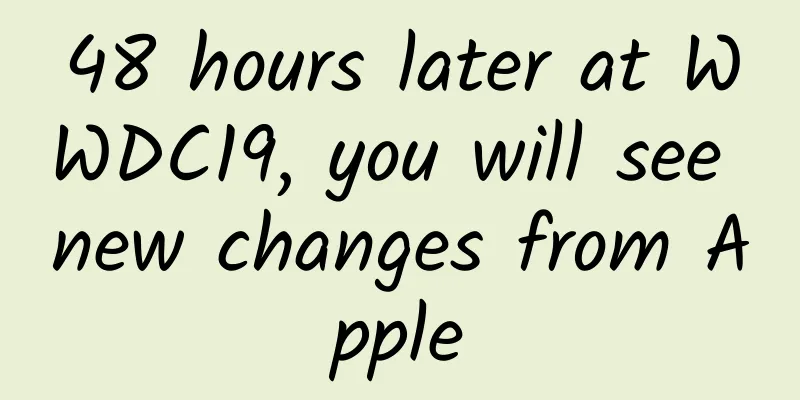48 hours later at WWDC19, you will see new changes from Apple

|
In less than two days, at 1:00 a.m. Beijing time on June 4, WWDC19 will open at the McEnery Convention Center in San Jose, California. More than 5,000 developers from all over the world will travel to San Jose to attend this most anticipated developer conference of the year. Not only developers, but also the updates of new versions of iOS, macOS, watchOS, etc. have attracted the attention of many ordinary users. Although all the answers will be revealed in the second half of tomorrow night, we can first spoil WWDC19 based on the existing information and speculate on the impact these changes may have on the Apple ecosystem. iOS 13: General upgrade, iPad-oriented Mark Gurman, a Bloomberg reporter who has been covering Apple for many years, published an article in early May about possible updates from Apple at WWDC19. According to people familiar with the matter, Apple’s development plans may not be synchronized with the press conference, which means that some of the following features may not be fully unveiled in the first version of iOS 13. 9to5Mac also began to release the iOS 13 update details they learned in April. On May 28, they even released screenshots of iOS 13. Judging from the screenshots and reports, the updates in iOS 13 are expected to include but not limited to the following features:
The "official version" function is similar to that of existing applications, that is, using the iPad as the second display of the Mac. The current iOS applications Duet and Luna Display have achieved this effect. The file management app "Files" for iPad on iOS 12 will better support third-party software. In the past year, Apple has increasingly enriched its iPad product line, from the new iPad Mini of more than 2,000 yuan to the iPad Pro of more than 8,000 yuan, all of which have begun to support Apple Pencil and external keyboards. iOS 12 is also regarded as a new generation of systems that "both smooth the old devices and meet the operating needs of the new generation of iPads." In iOS 13, many new features and interaction logic are more inclined to serve the iPad. For example, from the simple left and right dual screens (iPad Pro 12.9 inches can be divided into three screens of left, middle and right) to multi-tasking and multi-windows, and even the introduction of the concept of "depth" in addition to tiling; "undo", a common operation on the PC side, is introduced to the iPad with gestures; the calculator application appears as a floating window; previously, Federico Viticci of MacStories, a well-known "heavy iPad user", mentioned on his podcast that the iPad Pro may support Bluetooth mouse and trackpad. Since the release of the redesigned iPad Pro last year, both technology critics and ordinary users have praised the hardware design and powerful configuration, but most of them have also expressed the view that "the software has held the hardware back." The introduction of the Type-C interface has not changed the gap between the iPad Pro and the PC in many operations, and some professional-level applications that were highly anticipated at the launch conference in October last year have not yet been officially released. From iPad to iPad Pro, Apple added a pen and a keyboard, and then changed the interface and screen-to-body ratio. What has not changed is that since the first generation iPad was released, it has still used iOS, the same operating system as the iPhone. Nowadays, mobile phone screens are getting bigger and bigger, and the display capabilities are getting better and better. The tablet market has not been prosperous in the past few years. The iPad has also experienced a rise and then decline since its birth. Until Apple launched the iPad Pro, it tried to make tablets get rid of the impression of demand for "large-screen mobile phones". The tablet market is still dead, but the iPad has regained its vitality. When the first generation of iPad was just released, the hot topic in public opinion was whether tablets were just enlarged versions of smartphones. Today, the discussion about the iPad as a product form itself has once again returned to the forefront of public opinion, but the object of comparison has changed from smartphones to computers. Regardless of whether it is truly "Pro", compared to when it was first released many years ago, the current discussion about whether the iPad can replace computers as a productivity tool has proved the rationality of the existence of this product line. Apple has introduced the features previously exclusive to iPad Pro to other iPad products in a way that is almost "revolutionizing its own product line". The addition of the A12 chip also means that these iPads will not be dragged down by performance in the next two or three years. Last June's WWDC has begun to embrace "iOS for iPad". As the product line with the biggest changes and the most updates since October last year, Apple will definitely take another big step in "iOS for iPad" this year. If they don't want to take it, the iPad Pro users accumulated in recent years will force them to take it. Therefore, the most likely changes in iOS 13 are appearance and function for the iPhone, and interaction logic for the iPad. macOS 10.15: On par with iOS In addition to iOS 13, macOS 10.15 is another major upgraded system, and this year its upgrade direction is "integration". According to a previous report by Bloomberg, Apple has a plan called "Marzipan" that aims to connect the development and application between macOS and iOS. Apple will provide developers with a new software development kit so that developers who want to develop macOS and iPad applications do not have to write two versions of the underlying software code. This integration plan is expected to be included in the iPhone next year. In addition to development, the completed update is migration. Apple may bring "highly restored" iOS native applications such as Podcasts, Find My, Screen Time, Shortcuts for Siri, the new version of the Reminders app, Apple Books, etc. to macOS. There were also rumors that iTunes would be discontinued after WWDC 19. As of May 31, the official Facebook and Instagram pages of iTunes have been completely cleared, which seems to confirm the previous foreign media reports that Apple will release three independent applications on macOS: Music, TV, and Podcasts to replace the current iTunes that includes these three main functions. In the era of streaming media, the demand for database management has become increasingly marginalized, and it is not yet known whether the content management function will be retained in the new independent application. The iPad may be used as a second monitor for the Mac and may support an external mouse; Apple is trying to integrate iOS and macOS starting from the bottom-level code; iOS will port native applications and services to macOS starting with Siri; iTunes may be split up 18 years after its birth... All these speculations that are waiting for time to be verified point in one direction - integration. This is not just an organic ecosystem formed between Apple's various systems, nor is it a universal Apple ID, nor is it just cross-device and cross-platform functions or services such as AirDrop, iCloud, and keys. This integration is based on development and in-depth interaction, and is reflected in the core of the software-applications. Apple once said that there will be no touch screens in the MacBook series. Apple will not develop a system for the iPad alone. As the iPad moves towards Pro, macOS must maintain its uniqueness, and Apple needs to consolidate it with a complete ecosystem, even "holding" the core users, while making developers willing to stay on this platform. Relying on strict application rules and complex adaptation parameters between different devices will only wear down the enthusiasm of developers. Integration may be exactly what ordinary users need and what developers hope for. It is a major trend that Apple can make the software ecosystem last forever in the future. watchOS and tvOS If the theme of macOS is "integration", then watchOS 6 is the opposite, and its more likely direction is "independence". According to reports, Apple plans to add an Apple Watch Store independent of the iPhone on the Apple Watch, where users can view and download apps directly on the Apple Watch. watchOS 6 may also add recording, calculator, and Apple Books for audible audiobooks independent of the iPhone. Animoji and Memoji are also expected to appear on watchOS 6. Of course, there will be new watch faces. The newly added watch faces may be "complex", that is, they will display more information on the Apple Watch face instead of just the time and date. They may also include complex weather information, current ambient noise, Bluetooth device battery life... Apple's spring conference in March was unusual, releasing hardware updates ahead of schedule and only introducing services at the conference. The launch of the streaming service Apple TV+ also means that tvOS, a system that has been "sidelined" in recent years, may have a major update at this year's WWDC, or it may be completely "marginalized" by the TV Plus application. Hardware can also be expected Although strictly speaking, WWDC is a developer conference held by Apple rather than a hardware conference, we can still expect the release of two hardware products at this WWDC. On May 22, Apple quietly launched the 2019 MacBook Pro series, which has no major updates except for the configuration upgrades year by year. But another product line is different, that is the Mac Pro, which has not been updated since its launch in 2013. In 2017, Apple's chief marketing officer Phil Schiller said that Apple was "completely rethinking" the Mac Pro product line. Tom Boger, Apple's senior director of Mac product marketing, said in an interview with TechCrunch, "We want developers to know that the Mac Pro will be a 2019 product." WWDC is the best time for developers to debut the long-awaited new Mac Pro. In addition, there are multiple reports and rumors, and Tianfeng Securities analyst Ming-Chi Kuo once said in an investment report that Apple may release a 31.6-inch 6K display with a resolution of 6240×2880 pixels. It uses a display panel with miniLED technology and a very sturdy shell material. Mac Pro is equipped with Apple 6K display. Perhaps this set of top-level equipment for Apple developers will be officially available to us the day after tomorrow. Don’t forget AR Apple has been involved in the AR field for many years. Although AR software demonstrations are always indispensable at WWDC every year, the highlight of AR is only at the press conference. In the past year, Apple has recruited a large number of AR hardware and software talents, and also acquired several AR startups such as Spektral and Akonia Holographics. Since last year, there have been rumors that Apple is developing AR headsets, and even gave iGlasses as an "open secret" product. iPhone, iPad, Apple Watch, AirPods, HomePods... In the past decade or so, Apple has been enriching its hardware product line and building its own Apple Garden by launching a major new product every two or three years. However, despite the acclaim of AirPods, Apple has always found it difficult to replicate a groundbreaking hardware product like the iPhone. Previously, Apple analyst and commentator Neil Cybart said that the iPhone is Apple's Achilles heel. Whether it is macOS, watchOS or the entire Apple ecosystem, it is inseparable from the "foundation" of interaction between iPhone and iOS. In recent years, Apple has also tended to "take steady steps" in the research and development of the iPhone. Faced with the 5G wave, Apple seems a bit "sluggish", and it has constant conflicts with Qualcomm and Intel in the research and development of chips. Not surprisingly, iGlasses will not be unveiled at this WWDC or even this year, but Apple has invested so many years in AR, and both users and themselves may be waiting for a device that can truly lead the AR era. As expected, there will still be AR technology demonstrations at this WWDC, perhaps it will just be the continued development of ARKit 3. According to Guilherme Rambo of 9to5Mac, at WWDC19, ARKit will have new features such as detecting human postures and integrating with game controllers, and will launch a new supporting development application. What will iOS 13 mean for iPad? Will macOS and iOS merge or be independent? Can watchOS 6 make Apple Watch a big step closer to being an independent smart wearable device? Will tvOS, which most users have never experienced, be so unpopular? Will iTunes, which has been around for 18 years, be "dismembered" like this? These specific speculations will be verified soon, while some trends will only be perceived with hindsight much later in the future. Every year, a press conference that lasts less than three hours is so touching because it not only concerns Apple, but also the lives of hundreds of millions of users around the world. See you tomorrow night. |
<<: iTunes is shutting down, and the era of "buying albums" is over
>>: Apple's four new systems are compatible with all devices, and the SE is not abandoned
Recommend
Two new high-risk areas added! Beijing currently has 4 high-risk areas
A reporter from the Beijing Daily client learned ...
What are the functions of the Guangzhou Campus Errands Mini Program? How much does it cost to create an errand running app?
Some time ago, a student came to us and said that ...
Microsoft Office iOS Preview 2.51 Update: PDF View is Clearer
[[408769]] According to MSPoweruser, Microsoft re...
When content becomes a burden, 13 tips to teach you how to turn content into a business asset!
Perhaps many people have a feeling that the compa...
Activity plan operation process template
This template has a certain scope of application ...
9 major processes of Tik Tok live streaming, a must-have operating guide for beginners!
In our previous articles, we have shared many met...
Will programmers be fired when they get older?
Internet companies like BAT may not recruit progr...
How to write a competitive product analysis, I have summarized 5 common problems and 1 set of methodology!
There is no doubt that competitive product analys...
Zhongzhi Douyou Club: Video tutorial on the latest rules for newbies to maintain Douyin accounts
I feel that it is more and more difficult to make...
iOS 15 iCloud Private Relay vulnerability leaks user's real IP address
[[426360]] The iCloud private relay service vulne...
How much does it cost to customize the Yulin Book Mini Program? What is the price for customizing the Yulin Books mini program?
There are two types of customization of Yulin Boo...
4 major mainstream platform information flow optimization cases, this wave of dry goods is very timely~
For information flow advertising , the content an...
WordPress video tutorial course on building a foreign trade website from scratch
WordPress video tutorial course on building a for...
What is the normal weight for a new Douyin account? What is the weight of the Douyin account I just applied for?
When posting videos on Tik Tok, the positioning a...
The pain points of my copywriting are obviously very "painful", so why is there no conversion?
Have you noticed that more and more heartfelt cop...









